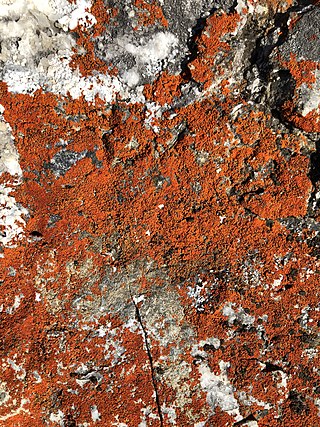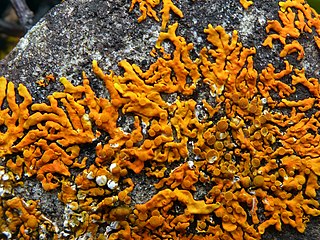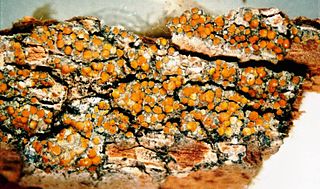
The Teloschistaceae are a large family of mostly lichen-forming fungi belonging to the class Lecanoromycetes in the division Ascomycota. The family has a cosmopolitan distribution, although members occur predominantly in subtropical and temperate regions. Most members are lichens that either live on rock or on bark, but about 40 species are lichenicolous – meaning they are non-lichenised fungi that live on other lichens. Many members of the Teloschistaceae are readily identifiable by their vibrant orange to yellow hue, a result of their frequent anthraquinone content. The presence of these anthraquinone pigments, which confer protection from ultraviolet light, enabled this group to expand from shaded forest habitats to harsher environmental conditions of sunny and arid ecosystems during the Late Cretaceous.

Flavoplaca is a genus of crust-like or scaly lichens in the family Teloschistaceae. It has 28 species with a mostly Northern Hemisphere distribution.

Igneoplaca is a genus in the subfamily Xanthorioideae of the family Teloschistaceae. It contains a single species, the crustose lichen Igneoplaca ignea.

Squamulea is a genus of lichen-forming fungi in the family Teloschistaceae. It has 15 species. The genus was circumscribed in 2013 by Ulf Arup, Ulrik Søchting, and Patrik Frödén, with Squamulea subsoluta assigned as the type species. Five species were included in the original account of the genus. The genus name alludes to the squamulose growth form of most of its species. Squamulea has a worldwide distribution; when the genus was originally created, the centre of distribution was thought to be in southwestern North America.

Dufourea is a genus of mostly foliose lichen species in the subfamily Xanthorioideae of the family Teloschistaceae. Species in the genus are mostly found in the Southern Hemisphere.

Cerothallia is a genus of crustose lichens in the family Teloschistaceae. It has four species, all of which occur in the Southern Hemisphere. The genus was circumscribed in 2013 by Ulf Arup, Patrik Frödén, and Ulrik Søchting, with Cerothallia luteoalba assigned as the type species. The type is more widely distributed, as it is also found in Europe and North America. The generic name Cerothallia means "with waxy thallus".
Sirenophila is a genus of crustose lichens in the subfamily Teloschistoideae of the family Teloschistaceae. It has four species with an Australasian distribution.
Huneckia is a genus of crustose lichens in the subfamily Caloplacoideae of the family Teloschistaceae. It has four species.

Wetmoreana is a genus of lichen-forming fungi in the family Teloschistaceae. It has two crustose, saxicolous (rock-dwelling) species.
Tassiloa is a genus of lichen-forming fungi in the family Teloschistaceae. It has two species.
Gondwania is a genus of lichen-forming fungi in the subfamily Xanthorioideae of the family Teloschistaceae. It has three species. The genus was circumscribed by lichenologists Ulrik Søchting, Patrik Frödén, and Ulf Arup. The type species is G. cribrosa, a species that was first named Polycauliona cribrosa by Auguste-Marie Hue in 1909. The genus name refers to the ancestral supercontinent Gondwana.
Marchantiana is a genus of lichen-forming fungi in the family Teloschistaceae. It contains seven species of corticolous (bark-dwelling), crustose lichens that occur in the Southern Hemisphere.
Eilifdahlia is a genus of lichen-forming fungi in the family Teloschistaceae. It contains three species of corticolous (bark-dwelling), crustose lichens that occur in the Southern Hemisphere.
Orientophila is a genus of lichen-forming fungi in the family Teloschistaceae. It has 15 species of mostly saxicolous (rock-dwelling), crustose lichens. All Orientophila species occur in Northeast Asia including China, Japan, South Korea, and the Russian Far East.
Cerothallia subluteoalba is a species of corticolous (bark-dwelling), crustose lichen in the family Teloschistaceae. Found in Australia, it was described as a new species in 2009. This species is distinguished by its numerous bright yellow to soft yellow-orange apothecia, tiny spores with slim dividers (septa), and a barely distinguishable thallus that either fades away or grows inside its host.
Sirenophila maccarthyi is a species of corticolous/lignicolous, crustose lichen in the family Teloschistaceae. It has a thallus that is whitish or greyish, often inconspicuous and not always continuous, which can appear darker or dirty grey near its numerous, clustered apothecia. Sirenophila maccarthyi is distributed across regions including Western Australia, New South Wales, Victoria, Tasmania, and New Zealand, in both coastal and inland habitats. It typically grows on the bark and dead wood of a wide range of trees and shrubs such as Acacia sophorae, Araucaria excelsa, and various Eucalyptus species.
Xanthocarpia erichansenii is a species of terricolous (ground-dwelling), crustose lichen in the family Teloschistaceae. It is found in southwest Greenland, where it grows on loess among mosses.
Fauriea trassii is a lichen species in the family Teloschistaceae, described in 2011. It is primarily found in the Far East of Russia, particularly in the Primorsky Krai region.
Dufourea angustata is a species of saxicolous (rock-dwelling), crustose lichen in the family Teloschistaceae. It is widely distributed across Australia.
Elixjohnia jackelixii is a species of saxicolous (rock-dwelling), crustose lichen in the family Teloschistaceae. It is found in Australia and New Zealand. The lichen is characterised by its unique multilayered appearance with outer sterile rings that are brownish or greenish-yellow and inner areoles that are whitish, yellowish, or greyish, often cracked to reveal the medulla underneath. Its fruiting bodies, or apothecia, are typically attached directly to the thallus and vary in colour and shape.








